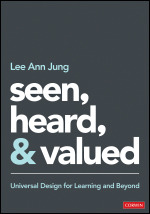Seen, Heard, and Valued
Universal Design for Learning and Beyond
- Lee Ann Jung - Lead Inclusion, San Diego State University, USA
To reach all, we must reach each
Every classroom is filled with amazing individuals who vary wildly in who they are as people. This includes BIPOC students, LGBTQIA+ students, and students who are new to the language of instruction, have learning differences, are experiencing poverty, need behavioral supports, have had poor previous instruction, or have endured trauma. This diversity is an asset that educators can leverage when we ensure our instruction is tailored to the strengths and needs of each student. That’s where Universal Design for Learning (UDL) comes in.
UDL ensures all students succeed by enabling educators to remove barriers to learning. Supported by neurological and education research, the tenets of UDL challenge educators to engage students and sustain their interest, represent instruction in accessible ways, and support students to demonstrate their learning in multiple ways. This guide shows how UDL can serve as a pathway to equitable learning outcomes through
- Practical advice for creating safe, affirming learning environments that encourage belonging
- Demonstration of how to represent content, concepts, and skills in different ways to provide students with multiple modes of expression
- Tables for planning and reflection
- Graphics illustrating multiple means of expression
By applying UDL principles, educators can anticipate potential barriers to learning and adjust from the start, driving the accessibility of learning for all students by meeting the needs of each student.
Free resources
Universal Design for Learning and Beyond Webinar
In this webinar, Lee Ann facilitates thinking around Universal Design for Learning as a means to bring equity in learning experiences and outcomes for a broad range of student variability.
Remove Barriers to Student Engagement
Our students’ focus, participation, and interest in the activities of their learning are what we call “engagement”. But the benefits of engagement extend far beyond what we can see in the moment. Our long-term goal is for students to gain the skills of curiosity, focus, persistence, and self regulation. Download this excerpt for strategies you can test to build and maintain student engagement.
Environments Where Students Feel Welcome
When we think of inclusivity, it’s natural to envision ways to provide access for students who have academic or physical needs. Although this is certainly a key feature of equitable classrooms, the precursor to inclusive instruction and assessment is establishing an emotionally safe culture. This resource includes specific strategies you can use to be intentionally inviting to your students.
